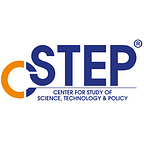Technology Options and Policy Solutions for a Future Powered by Renewable Energy
By Arshiya Bhutani, CSTEP.
Flexibility in the grid is paramount for India to meet its renewable energy (RE) ambitions — 450 GW by 2050 as announced by Prime Minister Narendra Modi in 2019. Energy storage systems can enable this flexibility.
Energy storage systems are the next step in India’s transition to an RE-dominant future. Although high carbon-emitting thermal energy sources such as coal and petroleum make up a majority of India’s energy production, India has set ambitious RE goals — aiming to make RE 80% of its energy mix. Achieving these goals can help India cut its carbon emissions significantly. But a key challenge is the intermittent nature of RE and its implications on grid stability. Energy storage systems can resolve this and help manage and distribute power effectively without destabilising the grid.
It is in this context that the India Energy Transformation Platform (IETP) — an independent group of experts constituted to formulate alternatives that would help India move towards a deeply decarbonised future by 2050 — undertook a study to find energy storage technologies that are relevant to India and recommended strategies for their application.
The study identified storage systems and sector coupling as crucial interventions that can help India achieve both its energy and climate goals. It assessed 27 technologies (and shortlisted 13 technology solutions and three policy solutions) that could provide complementary benefits to the Indian power system and also be indigenously manufactured.
Considering that by 2032, the cumulative demand for energy storage systems in India is expected to be over 2,700 GWh and given the scale of demand, there is a pressing need for domestic development of these solutions. The key challenges lie in enabling indigenous manufacturing and deepening power markets to create revenue sources for the identified technologies. Therefore, policies need to focus on creating an ecosystem that facilitates end-to-end deployment of new technologies.
IETP adopted a three-stage evaluation process to shortlist technologies suitable for India. In the first two stages, IETP rated the technologies based on their technical characteristics and then further shortlisted them based on their ease of deployment in the Indian context. In the third stage, IETP assessed the utility of the technology in the system. Based on this three-stage criteria, it identified power-to-hydrogen, vanadium redox flow batteries, and pumped–hydro storage as promising storage technologies to develop and sustain an RE-dominant power system in the long term.
How Can Policy Intervene?
Energy Storage
Lithium batteries dominate the current narrative on energy storage systems but could aggravate India’s energy security woes. In this scenario, IETP sees potential in alternative battery storage solutions such as vanadium redox flow batteries. They are not only durable with negligible degradation of electrolytes and electrodes but also have a safe and flexible design. These batteries can also help reduce import dependency and can be manufactured indigenously.
Power-to-hydrogen and pumped–hydro storage have also shown immense potential as energy storage solutions for India. However, power-to-hydrogen is still a new technology and, therefore, requires a clear pathway designed for technology commercialisation; in the short term, policies could look at increasing the use of hydrogen as a transport fuel with fuel cell electric vehicles being at the cusp of commercialisation. IETP has recommended a reassessment of potential sites for pumped–hydro storage solutions for future development. India’s policies should also clarify capacity development targets to investors.
Financing
Policies for enabling the efficient utilisation of storage assets are required to ensure their economic viability. Moreover, India needs to design effective tariff and compensation structures for various services. Also, policies designed to distribute capex investments among multiple stakeholders can act as an incentive to install storage solutions. To reduce potential risks involved in setting up pumped–hydro storage solutions, such as land acquisition challenges, IETP suggests developing an alternative model of ownership where the government handles the site evaluation and land acquisition and private entities and PSUs are only involved in developing the infrastructure.
IETP also recommends that profitable central public sector undertakings be mandated to undertake research and development in new technology options.
Sector Coupling
At present, India’s RE is dominated by the power sector. However, sector coupling, through electrification of industries such as transport and building heating, can help us achieve the twin goal of power system flexibility and reduction of carbon emissions. It is a crucial step in enabling primarily fossil-fuel dependent sectors to decarbonise by relying on RE. Currently, hydrogen presents an attractive incentive to Li-ion battery-powered electric vehicles. Power-to-hydrogen is a promising technology in India when it is supported through sector coupling. It is a useful storage medium for RE and a green fuel for other allied sectors such as metals, transport, and industrial chemicals.
Conclusion
India must move towards integrating more RE into the energy sector if it is to meet its Nationally Determined Contributions (NDCs) and climate goals. But to make RE the dominant energy mix, India needs to focus on integrating complementary energy storage systems across the nation to enable greater flexibility to accommodate the intermittent nature of RE. Incorporating various sectors — such as transport and building heating — with RE can initiate our journey to a genuinely RE-dominant future where RE is not only seen in the power sector but also across other fossil-fuel intensive industries.
About IETP: The India Energy Transformation Platform is an informal, independent, multi-stakeholder group of experts aiming to develop an informed narrative on India’s strategies for meeting its Nationally Determined Contributions (NDCs) through non-linear, transformative solutions. This unique initiative hopes to ensure that India stays ahead of the curve and cements its leadership in the global transition to clean energy — even beyond 2030.
